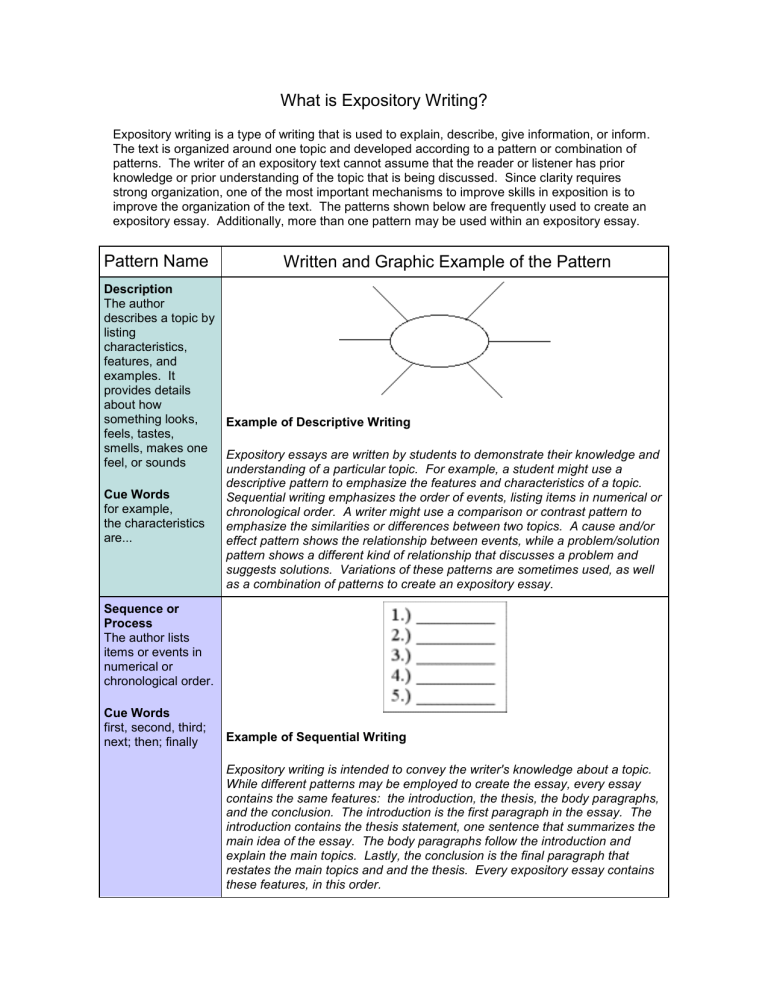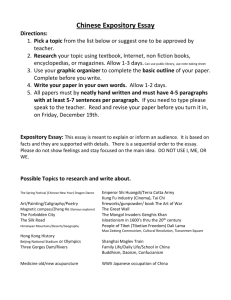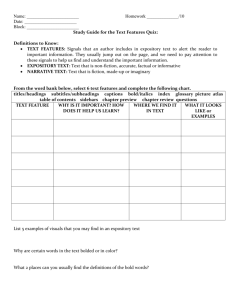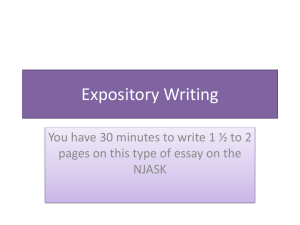What is Expository Writing

What is Expository Writing?
Expository writing is a type of writing that is used to explain, describe, give information, or inform.
The text is organized around one topic and developed according to a pattern or combination of patterns. The writer of an expository text cannot assume that the reader or listener has prior knowledge or prior understanding of the topic that is being discussed. Since clarity requires strong organization, one of the most important mechanisms to improve skills in exposition is to improve the organization of the text. The patterns shown below are frequently used to create an expository essay. Additionally, more than one pattern may be used within an expository essay.
Pattern Name Written and Graphic Example of the Pattern
Description
The author describes a topic by listing characteristics, features, and examples. It provides details about how something looks, feels, tastes, smells, makes one feel, or sounds
Cue Words for example, the characteristics are...
Example of Descriptive Writing
Expository essays are written by students to demonstrate their knowledge and understanding of a particular topic. For example, a student might use a descriptive pattern to emphasize the features and characteristics of a topic.
Sequential writing emphasizes the order of events, listing items in numerical or chronological order. A writer might use a comparison or contrast pattern to emphasize the similarities or differences between two topics. A cause and/or effect pattern shows the relationship between events, while a problem/solution pattern shows a different kind of relationship that discusses a problem and suggests solutions. Variations of these patterns are sometimes used, as well as a combination of patterns to create an expository essay.
Sequence or
Process
The author lists items or events in numerical or chronological order.
Cue Words first, second, third; next; then; finally
Example of Sequential Writing
Expository writing is intended to convey the writer's knowledge about a topic.
While different patterns may be employed to create the essay, every essay contains the same features: the introduction, the thesis, the body paragraphs, and the conclusion. The introduction is the first paragraph in the essay. The introduction contains the thesis statement, one sentence that summarizes the main idea of the essay. The body paragraphs follow the introduction and explain the main topics. Lastly, the conclusion is the final paragraph that restates the main topics and and the thesis. Every expository essay contains these features, in this order.
Comparison
The author explains how two or more things are alike and/or how they are different. A comparison essay usually discusses the similarities between two things, while the contrast essay discusses the differences.
Cue Words different; in contrast; alike; same as; on the other hand
Example of Compare/Contrast Writing
Expository writing has distinct features that distinguish it from creative writing.
The content of an expository essay is factual and straight-forward while the content of a creative story is imaginative and symbolic. Expository essays are written for a general audience but creative stories are designed for a specific audience. The writing style of an expository essay is formal, standard and academic, while a creative story uses an informal and artistic style.
The organization of an expository essay is systematic and deliberate; on the other hand, the organization of a creative story is more arbitrary and artistic. Finally, the most important difference between the two types of writing is the purpose of the text. An expository essay is written to inform and instruct, while a creative story is written to entertain and captivate.
Cause / Effect
The author focuses on the relationship between two or more events or experiences. The essay could discuss both causes and effects, or it could simply address one or the other. A cause essay usually discusses the reasons why something happened. An effect essay discusses what happens after a specific event or circumstance.
Cue Words
Example of Cause/Effect Writing
There are several reasons why so many people attend the Olympic games or watch them on television. One reason is tradition. The name Olympics and the torch and flame remind people of the ancient games. People can escape the ordinariness of daily life by attending or watching the Olympics. They like to identify with someone else's individual sacrifice and accomplishment. National pride is another reason, and an athlete's or a team's hard earned victory becomes a nation's victory. There are national medal counts and people keep track of how many medals their country's athletes have won.
reasons why; if...then; as a result; therefore; because
Problem / Solution
The author states a problem and lists one or more solutions for the problem. A variation of this pattern is the question- and-
Example of Problem/Solution Writing answer format in which the author
One problem with the modern Olympics is that it has become very big and poses a question and then answers it. expensive to operate. The city or country that hosts the games often loses a lot of money. A stadium, pools, and playing fields must be built for the athletic events and housing is needed for the athletes who come from around the world. And all of these facilities are used for only 2 weeks! In 1984, Los
Cue Words the problem is; the dilemma is; puzzle is solved; question... answer
Angeles solved these problems by charging a fee for companies who wanted to be official sponsors of the games. Companies like McDonald's paid a lot of money to be part of the Olympics. Many buildings that were already built in the
Los Angeles area were also used. The Coliseum where the 1932 games were held was used again and many colleges and universities in the area became playing and living sites.
Source: http://web.gccaz.edu/~mdinchak/ENG101/expository_writing.htm






